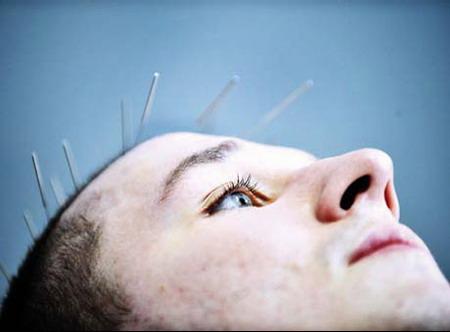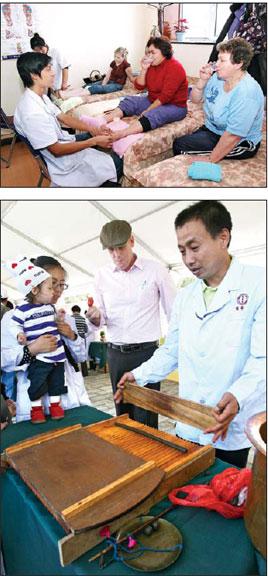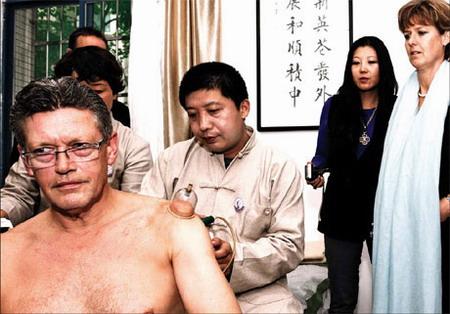
Patients from Russia are treated with traditional acupuncture, tuina massage and fire cupping at No 2 Affiliated Hospital at Heilongjiang University of Chinese Medicine in Harbin, Heilongjiang province. The hospital treated more than 300 foreign patients last year, 80 percent of them from Russia. [Photo / Xinhua]
Wang Ling, a 32-year-old housewife in Beijing, will soon set out on her special trip to Switzerland for sightseeing - and anti-aging sheep placenta therapy. The 10-day trip will cost her about 300,000 yuan ($46,300).
"I got to know about such trips from my health consultant at Ciming Health Checkup Center, and I am quite happy with the idea of combining tourism with the famed beauty treatment," she said.
As the Chinese get rich, many have moved from spree-buying luxury goods to paying more attention to their health, and they are willing to spend big on health preservation, according to Hu Bo, chairman of Ciming Health Checkup Management Group Co Ltd.
Wang, will be following the 200 or so clients of Ciming, a health examination chain with more than 30 outlets across the country, who traveled abroad for high-quality medical care last year. "The number has been constantly rising in recent years," Hu said.
His organization recommends such trips for clients and helps handle procedures such as visa applications and booking services at the destination. Some clients travel on their own initiative and some receive the trips as gifts, Hu said.
Destinations popular with the Chinese, besides Switzerland, include South Korea for cosmetic surgery, Hong Kong and the United States for childbirth, and Germany for general health checkups, with special attention to cancer.
A seven- to 10-day stay generally costs 300,000 to 500,000 yuan ($46,269 to $77,115), including first-class airfare, accommodations and health services.
"Actually, such health services especially the health preservation therapies, can also be obtained within the country and probably at a much lower price," said Xu Shuo, secretary-general of the Beijing Medical Doctor Association. "But the rich still would like to pay heavily, seeking better services abroad, largely at hot tourism destinations."
Some patients also travel to other countries for cutting-edge and high-quality medical services such as cancer treatment and some operations that domestic hospitals cannot provide, he said.
For example, in 2008 China's top hurdler, Liu Xiang, went to the US for an operation on his Achilles tendon, although Xu said such surgery is widely available in China.
"Our technology and clinical practice about that are up to international standards," Xu said, "but matching services and capacity like post-operative recovery and follow-ups lag far behind."
Besides, Hu said, foreign healthcare providers are better at promoting their programs among the target customers in China.
Switzerland, for example, has successfully branded itself as the top provider of the trademark anti-aging therapy using sheep placentas. It lures tens of thousands of customers from abroad, although Hu said few Swiss would go for the therapy.
Market potential

Zaets Andrey, 27, undergoes acupuncture at No 2 Affiliated Hospital. He has suffered from spastic quadriplegia for three years, but his mother, Hernova Ludmula, said his condition was improving after 20 days' treatment. Andrey is from Sochi, Russia, on the Black Sea. [Photo / Xinhua]
Despite the increasing number of Chinese choosing medical tourism, the business is still a fledgling with considerable untapped market potential, Hu said.Renee Marie Stephano, president of the US-based Medical Tourism Association, expressed confidence in the Chinese market. The country's surging economy has produced a sharp increase in the number of ultra-wealthy residents and they are all potential customers, she said.
According to the annual Asia-Pacific Wealth Report by Merrill Lynch and Capgemini, China now has 6,000 super-rich citizens - those with at least $30 million in investable assets. Japan has 5,300.
A recent survey by Rupert Hoogewerf, who ranks China's rich each year, showed that of all their expenditures, traveling took up the lion's share. Previously, the rich spent more on buying luxuries.
Given that China's medical services are among the most affordable in the world, Stephano said, only the rich go out of the country for quality services at high price.
Internationally, about 6 million people - largely from the United States, Japan, Europe and the Middle East - went abroad last year seeking medical services, mostly for a lower price or shorter waiting period, experts estimated. About 1.2 million of them chose Thailand and 450,000 India.
The cost of surgery in India, Thailand or South Africa can be one-tenth the cost in the US or Western Europe, sometimes less, according to an article in UDaily, a University of Delaware publication.
A heart-valve replacement that would cost $200,000 or more in the US, for example, goes for $10,000 in India - and that includes round-trip airfare and a brief vacation package, the article said. A metal-free dental bridge worth $5,500 in the US costs $500 in India, a knee replacement in Thailand with six days of physical therapy costs about one-fifth of what it would in the States, and Lasik eye surgery worth $3,700 in the US is available in many other countries for $730.
Cosmetic surgery savings are even greater: A full face-lift that would cost $20,000 in the US runs about $1,250 in South Africa, it said.
A forecast by Deloitte Consulting, published in August 2008, projected that medical tourism originating from the US could jump tenfold over the next decade. An estimated 750,000 Americans went abroad for health care in 2007, and the number reached roughly 1.5 million in 2010.
Convenience and speed also attract medical tourists, Stephano said. The increasing ease and affordability of international travel, along with improvements in technology and standards of care in many countries, also help the business.
Countries that operate public healthcare systems are often so taxed that patients must wait a considerable time for non-urgent medical care. In Canada, for example, 782,936 Canadians spent time on medical waiting lists - waiting an average of 9.4 weeks - in 2005, the most recent data available.
Big and getting bigger
 Medical tourism is worth about $60 billion worldwide ,according to report by Deloitte. Further increases are expected as people age and seek more affordable treatments around the world.
Medical tourism is worth about $60 billion worldwide ,according to report by Deloitte. Further increases are expected as people age and seek more affordable treatments around the world.Stephano, whose association promotes medical tourism, said that popular destinations include Argentina, Brunei, Cuba, Colombia, Costa Rica, Hong Kong, Hungary, India, Singapore, Thailand and, more recently, Saudi Arabia, the United Arab Emirates, South Korea, Tunisia and New Zealand.
To cash in on the trend, more than 50 countries have identified medical tourism as a national industry.
Medical tourism on China's mainland is primarily outbound, Stephano said. "What we need to do is try to develop patients inbound by letting people everywhere know that there is high-quality, affordable accessibility for medical services here," she said.
Traditional Chinese medicine and a combination of Eastern and Western medicine are unique to China, she said, and would provide a competitive edge.
Ciming's Hu suggested that Chinese authorities invest a bit more to address staff training and language and cultural barriers. He also urged the central government to develop a strategy and guidelines to build the industry.
He said encouraging measures might include a simplified visa application for medical tourism, programs catering to foreigners at large public hospitals, risk controls, and strengthened communication and cooperation with insurance companies worldwide.
Only limited regions - Hainan and Guangdong provinces, Shanghai and Beijing - have policies and platforms to develop inbound medical tourism featuring low-priced experimental medical procedures such as stem-cell treatment and TCM therapies, said Yang Jian, CEO of the Shanghai Medical Tourism Platform.
"The industry, if well developed, would benefit domestic health providers and stimulate more spending of coming visitors."
For example, Yang said, three TCM clinics on tropical Hainan island recorded annual income of 100 million yuan from Russian patients alone.
Also, "given our practical reality, China can provide medical treatment for certain diseases that are rarely seen elsewhere." Yang said his organization has been talking with US miners suffering from black lung disease about treatment in Shanghai.
He estimated that 10,000 to 20,000 foreigners came to Shanghai for medical services each year from 2008 to 2010.
Many are from the US, where roughly 50 million people have no health insurance and come to China for procedures such as cancer treatment using Gamma Knife and stem cell at more affordable prices, Yang said. "Usually it's a two- to four-week stay, which costs an average of $10,000."
There are risks

Julian Stainton, chief executive of the Western Provident Association, one of the UK's leading health insurers, gets a taste of traditional Chinese medicine. He received a tuina massage in the fall in Xi'an, Shaanxi province. [Photo / China Daily]
Not all countries that are going after medical tourists may be safe, Stephano said, because accreditation and other measures of quality vary widely.
"Our association provides education and messages about global choices for medical services for the people to enable them to decide on their own," she said.
Some risks are common to tourism in general, experts warned, but others involve such issues as limited access to quality post-operative care and varied standards for healthcare around the world.
Qiu Renzong, a bioethics researcher at the Chinese Academy of Social Sciences, raised the possibility of major ethical issues such as the illegal trade of organs and tissues for transplant.
China banned transplant tourism and trade of organs for transplant in 2007.
Qiu also said that while stem cell treatment attracts many medical tourists, "in fact it is recognized by Chinese health authorities as on clinical trial, thus should not be widely practiced clinically".
Qiu urged the government to strengthen regulation over medical tourism even if it's still at its early stage.





